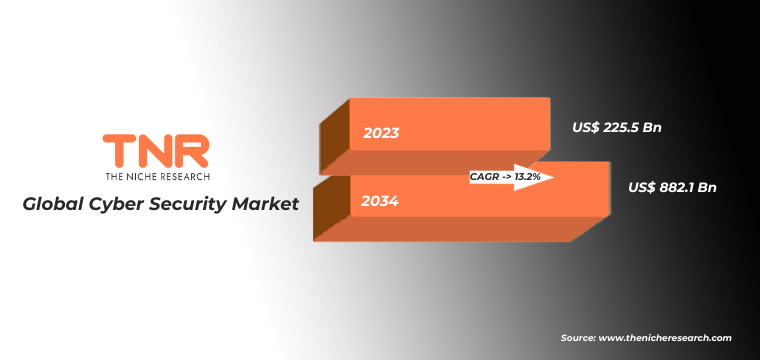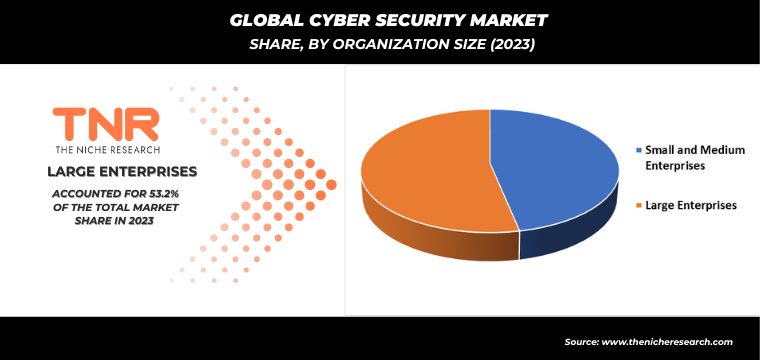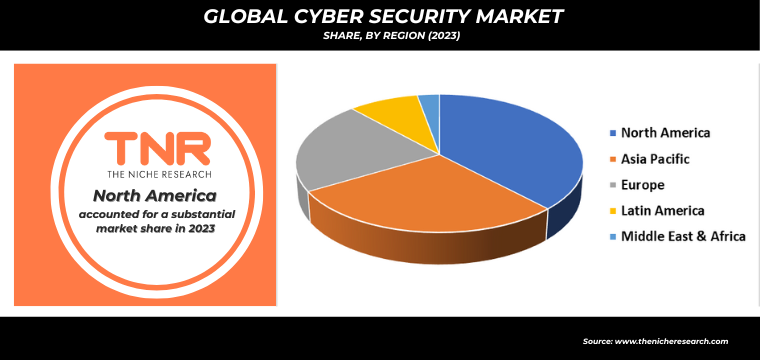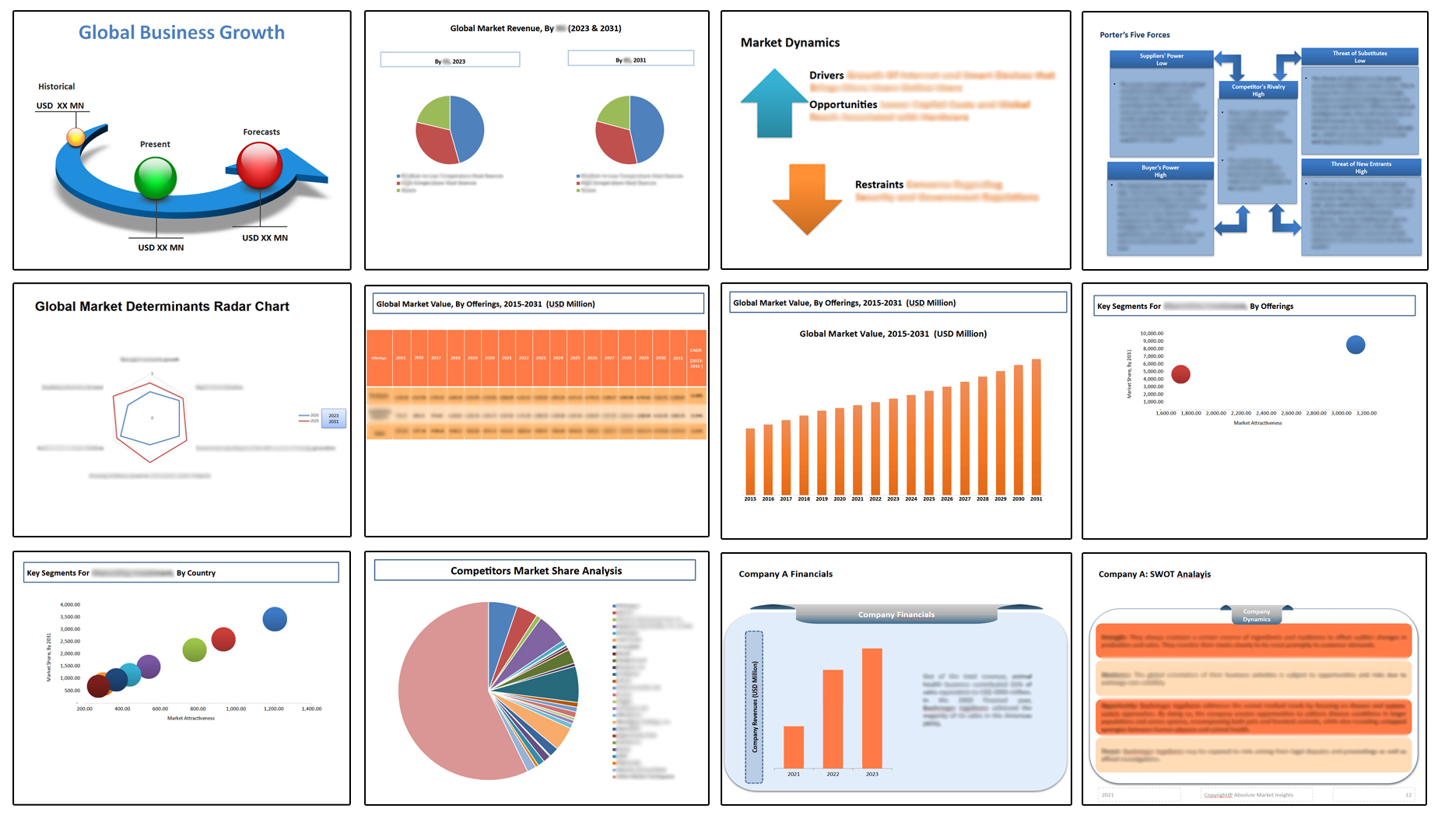Global Cyber Security Market: By Offering, By Deployment, By Organization Size, By End User, By Security type/Function, By Threat Type, By Region & Segmental Insights Trends and Forecast, 2024 – 2034
- Industry: Technology
- Report ID: TNR-110-1143
- Number of Pages: 420
- Table/Charts : Yes
- June, 2024
- Base Year : 2024
- No. of Companies : 10+
- No. of Countries : 29
- Views : 10138
- Covid Impact Covered: Yes
- War Impact Covered: Yes
- Formats : PDF, Excel, PPT
Cybersecurity is the practice of protecting systems, networks, and data from digital attacks, unauthorized access, and damage. It encompasses a wide range of technologies, processes, and measures designed to safeguard sensitive information and ensure the integrity, confidentiality, and availability of data. Key aspects of cybersecurity include threat detection, risk management, incident response, and the implementation of protective controls such as firewalls, encryption, and multi-factor authentication.
With the growing reliance on digital infrastructure and the increasing sophistication of cyber threats, cybersecurity has become a critical concern for individuals, businesses, and governments alike. Effective cybersecurity strategies involve not only deploying advanced technical solutions but also fostering a culture of security awareness and compliance with regulatory standards. By mitigating the risks of cyberattacks, cybersecurity helps maintain trust and resilience in the digital age.
The demand for cybersecurity is driven by several critical factors, including the increasing frequency and sophistication of cyberattacks, regulatory compliance requirements, and the widespread digital transformation across industries. As cyber threats such as ransomware, phishing, and data breaches become more prevalent and advanced, organizations are compelled to invest in robust cybersecurity measures to protect their sensitive data and maintain operational integrity. Regulatory frameworks like GDPR, HIPAA, and CCPA mandate stringent data protection practices, further driving the need for comprehensive security solutions.
Additionally, the rapid adoption of cloud computing, IoT, and remote work has expanded the attack surface, necessitating advanced cybersecurity strategies to safeguard digital assets. The financial and reputational risks associated with cyber incidents underscore the importance of cybersecurity, prompting businesses and governments to prioritize and invest in effective security measures to ensure resilience and trust in the digital landscape.
In terms of revenue, the global cyber security market was worth US$ 225.5 Bn in 2023, anticipated to witness CAGR of 13.2% during 2024 – 2034.

Global Cyber Security Market Dynamics
Increasing Cyber Threats: The global rise in cyberattacks, including ransomware, phishing, and advanced persistent threats (APTs), drives demand for robust cybersecurity solutions. As cybercriminals employ increasingly sophisticated techniques, businesses and governments must invest in advanced security measures to protect their digital assets. Emerging technologies like artificial intelligence (AI) and machine learning (ML) are being integrated into cybersecurity solutions to enhance threat detection and response capabilities. These advancements provide more effective and proactive security measures.

Regulatory Compliance: Stringent data protection regulations such as the GDPR, CCPA, and HIPAA require organizations to implement rigorous cybersecurity protocols. Compliance with these regulations drives investment in cybersecurity to avoid hefty fines and legal repercussions. Cyberattacks can result in significant financial losses due to business disruption, data breaches, and reputational damage. The economic implications of cyber incidents drive organizations to prioritize cybersecurity investments to safeguard their financial stability.

Digital Transformation: The rapid adoption of digital technologies, including cloud computing, IoT, and big data, expands the attack surface. Organizations transitioning to digital platforms require comprehensive cybersecurity strategies to secure their new digital ecosystems. The shift to remote work, accelerated by the COVID-19 pandemic, has increased the need for secure remote access solutions and endpoint security. Protecting distributed workforces from cyber threats is now a top priority for many organizations.

Service Segment has Garnered Major Market Share in the Global Cyber Security Market During the Forecast Period (2024 – 2034).
The demand for cybersecurity services is driven by the escalating frequency and sophistication of cyber threats, regulatory compliance needs, and the increasing reliance on digital infrastructure. As cyberattacks become more advanced, organizations across various sectors require specialized services to protect their sensitive data and ensure operational resilience. Regulatory mandates, such as GDPR, HIPAA, and CCPA, necessitate stringent data protection measures, prompting businesses to seek expert cybersecurity services to achieve compliance.
Additionally, the rapid adoption of cloud computing, IoT, and remote work environments expands the potential attack surface, heightening the need for comprehensive security strategies. Cybersecurity services offer specialized expertise, continuous monitoring, threat intelligence, and incident response capabilities that many organizations lack internally. This external support is crucial for proactively identifying vulnerabilities, mitigating risks, and responding swiftly to breaches. Consequently, the evolving threat landscape and stringent regulatory environment significantly drive the demand for robust cybersecurity services to safeguard digital assets and ensure business continuity.

By Organization Size Large Enterprise Segment had the Highest Share in the Global Cyber Security Market in 2023.
The demand for cybersecurity in large enterprises is driven by the increasing complexity and scale of cyber threats, regulatory compliance requirements, and the need to protect vast amounts of sensitive data. As large enterprises hold valuable information, they are prime targets for sophisticated cyberattacks such as ransomware, phishing, and advanced persistent threats (APTs). The financial, reputational, and operational risks associated with data breaches necessitate robust cybersecurity measures.
Additionally, regulatory frameworks such as GDPR, CCPA, and industry-specific standards mandate stringent data protection practices, compelling large enterprises to invest in advanced security solutions. The growing adoption of cloud services, remote work, and digital transformation initiatives further expands the attack surface, requiring comprehensive and adaptive cybersecurity strategies. Furthermore, the integration of AI and machine learning in enterprise operations necessitates heightened security to protect against emerging threats. These factors collectively drive large enterprises to prioritize and invest heavily in cybersecurity to safeguard their assets, ensure compliance, and maintain business continuity.

North America, by Region Dominated the Global Cyber Security Market in 2023.
In North America, the demand for cybersecurity is driven by several critical factors, including the rising incidence of cyberattacks, increasing regulatory requirements, and the growing digital transformation across industries. As businesses and government agencies increasingly rely on digital infrastructure, they face heightened risks from sophisticated cyber threats such as ransomware, phishing, and data breaches. This necessitates robust cybersecurity measures to protect sensitive information and maintain operational integrity.
Additionally, stringent regulatory frameworks, such as the General Data Protection Regulation (GDPR) and the California Consumer Privacy Act (CCPA), mandate stringent data protection practices, further driving the need for advanced cybersecurity solutions. The widespread adoption of remote work and cloud services has expanded the attack surface, compelling organizations to invest in comprehensive security strategies to safeguard their digital assets. These drivers collectively underscore the critical importance of cybersecurity in maintaining trust, compliance, and resilience in the increasingly digital landscape of North America.

Competitive Landscape: Global Cyber Security Market:
- Atos SE
- Broadcom
- Cisco Systems, Inc.
- CyberSapiens
- Dark Matter LLC
- Digital Security Company | DIGISEC
- EMTECH
- Fortinet, Inc.
- IBM
- Imperva
- Looptech Co.
- Microsoft
- Open Text Corporation
- Palo Alto Networks
- Thales
- Trend Micro Incorporated
- Other Market Participants
Global Cyber Security Market Scope
| Report Specifications | Details |
| Market Revenue in 2023 | US$ 225.5 Bn |
| Market Size Forecast by 2034 | US$ 882.1 Bn |
| Growth Rate (CAGR) | 13.2% |
| Historic Data | 2016 – 2022 |
| Base Year for Estimation | 2023 |
| Forecast Period | 2024 – 2034 |
| Report Inclusions | Market Size & Estimates, Market Dynamics, Competitive Scenario, Trends, Growth Factors, Market Determinants, Key Investment Segmentation, Product/Service/Solutions Benchmarking |
| Segments Covered | By Offering, By Deployment, By Organization Size, By End User, By Security type/Function, By Threat Type, By Region |
| Regions Covered | North America, Europe, Asia Pacific, Middle East & Africa, Latin America |
| Countries Covered | U.S., Canada, Mexico, Rest of North America, France, The UK, Spain, Germany, Italy, Nordic Countries (Denmark, Finland, Iceland, Sweden, Norway), Benelux Union (Belgium, The Netherlands, Luxembourg), Rest of Europe, China, Japan, India, New Zealand, Australia, South Korea, Southeast Asia (Indonesia, Thailand, Malaysia, Singapore, Rest of Southeast Asia), Rest of Asia Pacific, Saudi Arabia, UAE, Egypt, Kuwait, South Africa, Rest of Middle East & Africa, Brazil, Argentina, Rest of Latin America |
| Key Players | Atos SE , Broadcom, Cisco Systems, Inc., CyberSapiens, Dark Matter LLC, Digital Security Company | DIGISEC, EMTECH, Fortinet, Inc., IBM, Imperva, Looptech Co., Microsoft, Open Text Corporation, Palo Alto Networks, Thales , Trend Micro Incorporated |
| Customization Scope | Customization allows for the inclusion/modification of content pertaining to geographical regions, countries, and specific market segments. |
| Pricing & Procurement Options | Explore purchase options tailored to your specific research requirements |
| Contact Details | Consult With Our Expert
Japan (Toll-Free): +81 663-386-8111 South Korea (Toll-Free): +82-808- 703-126 Saudi Arabia (Toll-Free): +966 800-850-1643 United Kingdom: +44 753-710-5080 United States: +1 302-232-5106 E-mail: askanexpert@thenicheresearch.com
|
Global Cyber Security Market
By Offering
- Hardware
- Software
- Services
- Professional Services
- Managed Services
By Deployment
- Cloud
- On Premise
By Organization Size
- Small and Medium Enterprises
- Large Enterprises
By End-User
- Information Technology and Telecommunication
- Healthcare
- Education
- K-12
- Higher Education
- Energy and Utilities
- Banking, Financial Services and Insurance (BFSI)
- Government
- Transportation & Logistics
- Manufacturing
- Military and Defense
- Electrical and Electronics
- Hospitality
- Oil & Gas
- Retail
- Media & Entertainment
- Others
By Security Type/Function
- Data Protection
- Governance, risk and compliance
- Email security and awareness
- Cloud Security
- End-Point Security
- Identity and access management
- Security Consulting
- Network Security
- Application Security
- Others
By Threat Type
- Distributed Denial of Service (DDoS)
- Malware
- Phishing
- Spoofing
- Ransomware
- Others
By Region
- North America (U.S., Canada, Mexico, Rest of North America)
- Europe (France, The UK, Spain, Germany, Italy, Nordic Countries (Denmark, Finland, Iceland, Sweden, Norway), Benelux Union (Belgium, The Netherlands, Luxembourg), Rest of Europe)
- Asia Pacific (China, Japan, India, New Zealand, Australia, South Korea, Southeast Asia (Indonesia, Thailand, Malaysia, Singapore, Rest of Southeast Asia), Rest of Asia Pacific)
- Middle East & Africa (Saudi Arabia, UAE, Egypt, Kuwait, South Africa, Rest of Middle East & Africa)
- Latin America (Brazil, Argentina, Rest of Latin America)
Report Layout:

Table of Contents
Note: This ToC is tentative and can be changed according to the research study conducted during the course of report completion.
**Exclusive for Multi-User and Enterprise User.
Global Cyber Security Market
By Offering
- Hardware
- Software
- Services
- Professional Services
- Managed Services
By Deployment
- Cloud
- On Premise
By Organization Size
- Small and Medium Enterprises
- Large Enterprises
By End-User
- Information Technology and Telecommunication
- Healthcare
- Education
- K-12
- Higher Education
- Energy and Utilities
- Banking, Financial Services and Insurance (BFSI)
- Government
- Transportation & Logistics
- Manufacturing
- Military and Defense
- Electrical and Electronics
- Hospitality
- Oil & Gas
- Retail
- Media & Entertainment
- Others
By Security Type/Function
- Data Protection
- Governance, risk and compliance
- Email security and awareness
- Cloud Security
- End-Point Security
- Identity and access management
- Security Consulting
- Network Security
- Application Security
- Others
By Threat Type
- Distributed Denial of Service (DDoS)
- Malware
- Phishing
- Spoofing
- Ransomware
- Others
By Region
- North America (U.S., Canada, Mexico, Rest of North America)
- Europe (France, The UK, Spain, Germany, Italy, Nordic Countries (Denmark, Finland, Iceland, Sweden, Norway), Benelux Union (Belgium, The Netherlands, Luxembourg), Rest of Europe)
- Asia Pacific (China, Japan, India, New Zealand, Australia, South Korea, Southeast Asia (Indonesia, Thailand, Malaysia, Singapore, Rest of Southeast Asia), Rest of Asia Pacific)
- Middle East & Africa (Saudi Arabia, UAE, Egypt, Kuwait, South Africa, Rest of Middle East & Africa)
- Latin America (Brazil, Argentina, Rest of Latin America)
The Niche Research approach encompasses both primary and secondary research methods to provide comprehensive insights. While primary research is the cornerstone of our studies, we also incorporate secondary research sources such as company annual reports, premium industry databases, press releases, industry journals, and white papers.
Within our primary research, we actively engage with various industry stakeholders, conducting paid interviews and surveys. Our meticulous analysis extends to every market participant in major countries, allowing us to thoroughly examine their portfolios, calculate market shares, and segment revenues.
Our data collection primarily focuses on individual countries within our research scope, enabling us to estimate regional market sizes. Typically, we employ a bottom-up approach, meticulously tracking trends in different countries. We analyze growth drivers, constraints, technological innovations, and opportunities for each country, ultimately arriving at regional figures.Our process begins by examining the growth prospects of each country. Building upon these insights, we project growth and trends for the entire region. Finally, we utilize our proprietary model to refine estimations and forecasts.
Our data validation standards are integral to ensuring the reliability and accuracy of our research findings. Here’s a breakdown of our data validation processes and the stakeholders we engage with during our primary research:
- Supply Side Analysis: We initiate a supply side analysis by directly contacting market participants, through telephonic interviews and questionnaires containing both open-ended and close-ended questions. We gather information on their portfolios, segment revenues, developments, and growth strategies.
- Demand Side Analysis: To gain insights into adoption trends and consumer preferences, we reach out to target customers and users (non-vendors). This information forms a vital part of the qualitative analysis section of our reports, covering market dynamics, adoption trends, consumer behavior, spending patterns, and other related aspects.
- Consultant Insights: We tap into the expertise of our partner consultants from around the world to obtain their unique viewpoints and perspectives. Their insights contribute to a well-rounded understanding of the markets under investigation.
- In-House Validation: To ensure data accuracy and reliability, we conduct cross-validation of data points and information through our in-house team of consultants and utilize advanced data modeling tools for thorough verification.
The forecasts we provide are based on a comprehensive assessment of various factors, including:
- Market Trends and Past Performance (Last Five Years): We accurately analyze market trends and performance data from preceding five years to identify historical patterns and understand the market’s evolution.
- Historical Performance and Growth of Market Participants: We assess the historical performance and growth trajectories of key market participants. This analysis provides insights into the competitive landscape and individual company strategies.
- Market Determinants Impact Analysis (Next Eight Years): We conduct a rigorous analysis of the factors that are projected to influence the market over the next eight years. This includes assessing both internal and external determinants that can shape market dynamics.
- Drivers and Challenges for the Forecast Period:Identify the factors expected to drive market growth during the forecast period, as well as the challenges that the industry may face. This analysis aids in deriving an accurate growth rate projection.
- New Acquisitions, Collaborations, or Partnerships: We keep a close watch on any new acquisitions, collaborations, or partnerships within the industry. These developments can have a significant impact on market dynamics and competitiveness.
- Macro and Micro Factors Analysis:A thorough examination of both macro-level factors (e.g., economic trends, regulatory changes) and micro-level factors (e.g., technological advancements, consumer preferences) that may influence the market during the forecast period.
- End-User Sentiment Analysis: To understand the market from the end-user perspective, we conduct sentiment analysis. This involves assessing the sentiment, preferences, and feedback of the end-users, which can provide valuable insights into market trends.
- Perspective of Primary Participants: Insights gathered directly from primary research participants play a crucial role in shaping our forecasts. Their perspectives and experiences provide valuable qualitative data.
- Year-on-Year Growth Trend: We utilize a year-on-year growth trend based on historical market growth and expected future trends. This helps in formulating our growth projections, aligning them with the market’s historical performance.
Research process adopted by TNR involves multiple stages, including data collection, validation, quality checks, and presentation. It’s crucial that the data and information we provide add value to your existing market understanding and expertise. We have also established partnerships with business consulting, research, and survey organizations across regions and globally to collaborate on regional analysis and data validation, ensuring the highest level of accuracy and reliability in our reports.









